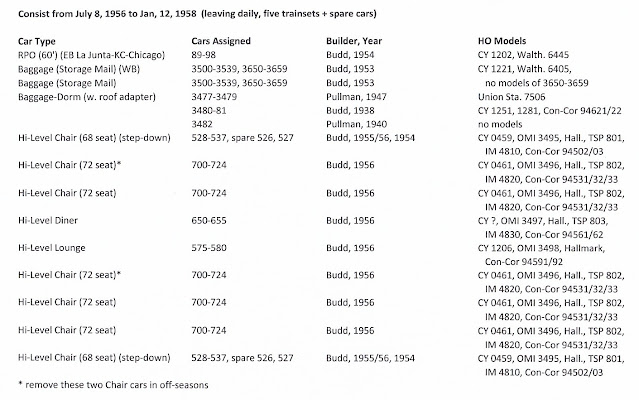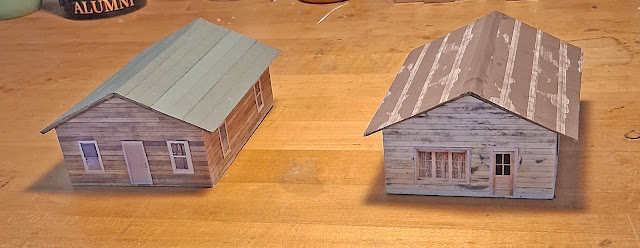This time we'll cover the Santa Fe's all-coach Hi-Level El Capitan train in Victorville from mid-1956 into early 1958, and then we'll cover a bit of layout progress and a steam train ride.
Let's begin by looking at a photo of the 1956 El Capitan after it had acquired its innovative new Hi-Level cars. Here it rounds a curve as it leaves Los Angeles Union Passenger Terminal behind F3 set #33:
From my El Capitan clinic slides of 2009, here are the cars that were added to the consist for the time period of July 1956 through Jan. 1958:
Here's one of the Santa Fe ads from the time period:
And an ad for the interior of the new Hi-Level Lounge car:
Here's the consist of this train, along with the HO models as of 2009:Happily, in 2012 Walthers released a complete HO train set for this train, as seen in this ad:
The cars offered by Walthers in 2012 were: the Baggage Car, Railway Post Office, Baggage-Dormitory "transition car", Hi-Level 68-Seat Step-Down Coach, Hi-Level 72-Seat Coach, Hi-Level "Sky Lounge", Hi-Level Diner, and Hi-Level 68-Seat Step-Down Coach with Tail Sign.
Here's a postcard view of the prototype train in Shoemaker Canyon, NM, in 1956:
Here we see a rear view of the train, with a step-down coach at the end:
Here's a publicity photo showing passengers boarding one of the new Hi-Level coaches:
The motive power during this time period were the EMD F3 and F7 ABBA sets. The F3 set numbers were 16-36 and the F7 set numbers were 37-47, plus 306-314. The 306-314 were ABB sets, but they always added an extra trailing A unit from the 300 series to make a complete ABBA set.
Regarding the schedules of the El Capitan through Victorville (it did not stop there), #21 came through at 4:12 a.m every morning,. and #22 came through at 4:23 p.m. every evening.
I don't need to model #21, as it came through westbound at night, but #22 was part of the afternoon parade of eastbound passenger trains. I can use the Walthers Hi-Level cars to model the July 8, 1956 and later train.
Here's a final slide covering the changes to the train in 1958 and later:
Now I'll include here my layout progress report from July 20:
At about the same time, I tested all three of these Mojave Northern locos to verify that they can pull the train of six rock cars, at least on level track.
We boarded the train and walked to the rear car, which has open windows and no seats, so that we can stand up and enjoy the rocking motions and move from the windows on one side to the other. I posed by the open door at the rear of the car:
We were enjoying all the sights from the open car. Here's a view of the car's interior, with Diane in the blue shirt in the middle:
When we arrived at Mineral, the loco uncoupled and ran forward around the train to couple onto the rear car, where we were riding:
The loco was now facing forward for the return trip, but with our open car now at the front. As we arrived back at the Elbe depot at 4:15 p.m., I shot this photo from a window of our open car:
Then the train backed up past the depot and parked on a siding, as seen here:
We walked back to our car and drove back home, but with a stop for dinner halfway home, in South Hill. We got home at 7:20 p.m., very tired but very happy for a wonderful steam train ride, and a wonderful 80th birthday gift for me.


























No comments:
Post a Comment